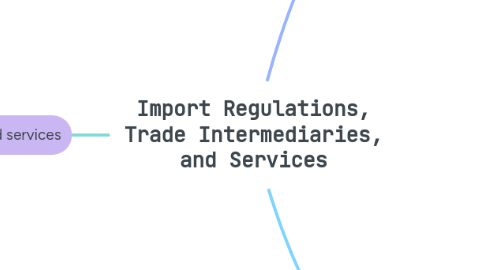
1. Trade intermediaries and services
1.1. Customs brokers
1.1.1. Customs brokers act as agents for importers with regard
1.1.1.1. (1) the entry and admissibility of merchandise
1.1.1.2. (2) its classification and valuation
1.1.1.3. (3) the payment of duties and other charges assessed by customs or the refund or drawback thereof.
1.2. free-trade zones
1.2.1. certain designated areas
1.2.2. usually located in or near a customs port of duty, where merchandise admitted is not subject to a tariff until it is entered into the customs territory.
1.2.3. Foreign goods brought into an FTZ may be stored, or otherwise manipulated or manufactured
1.2.4. FTZs are legally considered to be outside the customs territory of a country
1.3. bonded warehouses
1.3.1. Bonded warehouses are secured
1.3.2. government-approved warehouse facilities in which imported goods are stored or manipulated without payment of duty until they are removed and entered for consumption.
2. Tariffs and nontariff barriers
2.1. barriers Methods of levying tariffs
2.1.1. Ad valorem
2.1.1.1. Duty based on value of the imported product
2.1.2. Specific
2.1.2.1. Duty based on quantity or volume
2.1.3. Compound
2.1.3.1. Duty that combines both ad valorem and specific
2.2. Nontariff Barriers
2.2.1. quotas
2.2.2. tariff quotas
2.2.3. labeling requirements
2.2.4. licensing requirements
2.2.5. prohibitions on the entry of certain imports
2.2.6. requirements to purchase domestically produced goods.
3. Preferential trading arrangements
3.1. The North American Free Trade Agreement (NAFTA) (1994)
3.1.1. 60 percent regional value content (transaction value method)
3.1.2. 50 percent value content using the net cost method.
3.2. The U.S./Israel Free-Trade Agreement (1985)
3.2.1. no less than 35 percent of the import value.
3.3. U.S./Australia Free Trade Agreement (USAFTA) (2004)
3.3.1. provides for the elimination of tariffs on more than 97 percent of Australia’s nonagricultural exports
3.4. The Caribbean Basin Initiative (CBI) (1984)
3.4.1. no expiration date
3.5. The Andean Trade Preference (ATP) (1991)
3.5.1. no expiration date
3.6. Generalized System of Preferences (GSP) (1976)
3.6.1. no less than 35 percent of the appraised value of the goods.
